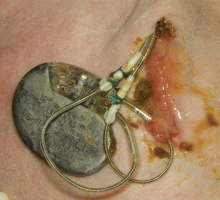Cardiovascular implantable electronic device infection: A stepwise approach to diagnosis and management
ABSTRACTInfection related to cardiovascular implantable electronic devices is a serious complication, necessitating removal of the device and prolonged parenteral antibiotic therapy. Accurate diagnosis and optimal management of these infections are challenging. This review highlights the critical management decisions.
KEY POINTS
- Although inflammatory signs at the generator pocket are the most common presentation of an infection occurring soon after the device is implanted, positive blood cultures may be the sole manifestation of a late-onset endovascular infection.
- Staphylococci are the most common pathogens in both pocket infections and endovascular infections.
- Two sets of blood cultures should be obtained in all patients suspected of having a cardiac device infection.
- Transesophageal echocardiography should be ordered in all patients with suspected cardiac device infection who have positive blood cultures, as it can identify intracardiac complications of infection and assess for evidence of cardiac valve involvement.
STAPHYLOCOCCI ARE THE MOST COMMON CAUSE
A key to making an accurate diagnosis and determining the appropriate empiric antibiotic therapy is to understand the microbiology of device infections.
Regardless of the clinical presentation, staphylococci are the predominant organisms responsible for both early- and late-onset infections.17,18 These include Staphylococcus aureus and coagulase-negative staphylococci. Depending on where the implanting hospital is located and where the organism was acquired (in the community or in the hospital), up to 50% of these staphylococci may be methicillin-resistant,17,18 a fact that necessitates using vancomycin for empiric coverage until the pathogen is identified and its susceptibility is known.
Gram-negative or polymicrobial CIED infections are infrequent. However, empiric gram-negative coverage should be considered for patients who present with systemic signs of infection, in whom delaying adequate coverage could jeopardize the successful outcome of infection treatment.
Fungal and mycobacterial infections of cardiac devices are exceedingly uncommon, mainly occurring in immunocompromised patients.
CLINICAL MANIFESTATIONS OF CARDIOVASCULAR DEVICE INFECTION
The clinical presentations of CIED-related infection can be broadly categorized into two groups: generator pocket infection and endovascular infection with an intact pocket.17,18
Generator pocket infection
Most patients with a pocket infection present with inflammatory changes at the device generator site. Usual signs and symptoms include pain, erythema, swelling, and serosanguinous or purulent drainage from the pocket.
Patients with a pocket infection generally present within weeks to months of implantation, as the predominant mechanism of pocket infection is contamination of the generator or leads during implantation. However, occasionally, pocket infection caused by indolent organisms such as Propionibacterium, Corynebacterium, and certain species of coagulase-negative staphylococci can present more than 1 year after implantation. Hematogenous seeding of the device pocket, as a result of bacteremia from a distant primary focus, is infrequent except in cases of S aureus bloodstream infection.19
Endovascular infection with an intact pocket
A subset of patients with CIED-related infections, mostly late-onset infections, present only with systemic signs and symptoms without inflammatory changes at the generator pocket.16–18 Most of these patients have multiple comorbid conditions and likely acquire the infection via hematogenous seeding of transvenous device leads from a distant focus of primary infection, such as a skin or soft-tissue infection, pneumonia, bacteremia arising from an implanted long-term central venous catheter, or bloodstream infection secondary to an invasive procedure unrelated to the CIED.
Most patients with an endovascular device infection have positive blood cultures at presentation. However, occasionally, blood cultures may be negative. The main reason for negative blood cultures in this setting is the use of empiric antibiotic therapy before blood cultures are drawn.
Endovascular device infections are further complicated by the formation of infected vegetations on the leads or cardiac valves in up to one-fourth of cases.16–18,20,21 This complication poses additional challenges in management, such as choosing the appropriate lead extraction technique, the waiting time before implanting a replacement device, and the optimal length of parenteral antimicrobial therapy. Many of these decisions are beyond the realm of internal medicine practice and are best managed by consultation with an infectious disease specialist and a cardiologist.







